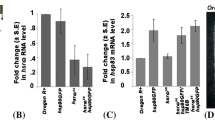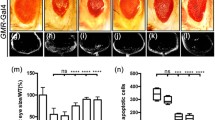Abstract
The non-coding hsrω gene of Drosophila melanogaster is expressed in nearly all cell types and developmental stages. However, in the absence of conventional mutant alleles of this gene, its developmental functions remain largely unknown. In the present study, we used a variety of GAL4 drivers to overexpress or ablate this gene’s transcripts in specific tissues and examined the developmental consequences thereof. Our results show that a balanced expression of these non-coding transcripts is critical for survival and normal development in all the tissue types tested, since any change in cellular levels of these transcripts in a given cell type generally has detrimental effects, with extreme cases resulting in organismal lethality, although in a few cases the misexpression of these transcripts also suppresses the mutant phenotype due to other genetic conditions. Evidence is also presented for existence of a new spliced variant of the hsrω-n nuclear transcript. Following the RNAi-mediated down-regulation of hsrω transcripts, the omega speckles disappear so that the nucleoplasmic hnRNPs get diffusely distributed, while up-regulation of these transcripts results in greater sequestration of these proteins into omega speckle clusters; either of these conditions would affect activities of the hnRNPs and other hsrω-RNA interacting proteins, which is likely to have cascading consequences. The present findings, together with our earlier observations on effects of altered levels of the hsrω transcripts on induced apoptosis and expanded polyQ-mediated neurodegeneration, further confirm that ncRNA species like the hsrω, far from being evolutionary hangovers, provide critical information for important functions in normal cells.




Similar content being viewed by others
Abbreviations
- AP or A/P:
-
anterior-posterior
- DIG:
-
digoxigenin
- EP:
-
enhancer promoter
- FRISH:
-
fluorescent RNA:RNA in situ hybridization
- hnRNP:
-
heterogeneous nuclear RNA-binding protein
- HP1:
-
heterochromatin protein 1
- IGC:
-
inter-chromatin granule cluster
- ncRNA:
-
non-coding RNA
- ORF:
-
open reading frame
- polyQ:
-
polyglutamine
- RISC:
-
RNA-induced silencing complex
- RNAi:
-
RNA interference
References
Bendena WG, Fini ME, Garbe JC, Kidder GM, Lakhotia SC and Pardue ML 1989 hsrω: A different sort of heat shock locus; in Stress-induced proteins (eds) ML Pardue, J Ferimisco and S Lindquist (Alan R Liss, Inc) pp. 3–14
Bendena WG, Ayme-Southgate A, Garbe JC and Pardue ML 1991 Expression of heat-shock locus hsrω in non-stressed cells during development in Drosophila melanogaster. Dev. Biol. 144 65–77
Brand AH and Perrimon N 1993 Targeted gene expression as a means of altering cell fates and generating dominant phenotypes. Development 118 401–415
Calleja M, Moreno E, Pelaz S and Morata G 1996 Visualization of gene expression in living adult Drosophila. Science 274 252–255
Ekengren S, Tryselius Y, Dushay MS, Liu G, Steiner H and Hultmark D 2001 A humoral stress response in Drosophila. Curr. Biol. 11 714–718
Fini ME, Bendena WG and Pardue ML 1989 Unusual behavior of the cytoplasmic transcript of hsromega: an abundant, stress-inducible RNA that is translated but yields no detectable protein product J. Cell Biol. 108 2045–2057
Garbe JC and Pardue ML 1986 Heat shock locus 93D of Drosophila melanogaster: a spliced RNA most strongly conserved in the intron sequence. Proc. Natl. Acad. Sci. USA 83 1812–1816
Garbe JC, Bendena WG, Alfano M and Pardue ML 1986 A Drosophila heat shock locus with a rapidly diverging sequence but a conserved structure. J. Biol. Chem. 261 16889–16894
Grimaud C, Bantignies F, Pal-Bhadra M, Ghana P, Bhadra U and Cavalli G 2006 RNAi components are required for nuclear clustering of Polycomb group response elements. Cell 124 957–971
Gurudatta BV, Shashidhara LS and Parnaik VK 2010 Lamin C and chromatin organization in Drosophila. J. Genet. 89 37–49
Han SP, Tang YH and Smith R 2010 Functional diversity of the hnRNPs: past, present and perspectives. Biochem. J. 430 379–392
Hay BA, Wolff T and Rubin GM 1994 Expression of baculovirus P35 prevents cell death in Drosophila. Development 120 2121–2129
Hinz U, Giebel B and Campos-Ortega JA 1994 The basic-helix-loop-helix domain of Drosophila lethal of scute protein is sufficient for proneural function and activates neurogenic genes. Cell 76 77–87
Hovemann BT, Waldorf U and Ryseck RP 1986 Heat shock locus of 93D of Drosophila melanogaster: An RNA with limiting coding capacity accumulates precursor transcripts after heat shock. Mol. Gen. Genet. 204 334–340
Hrdlicka L, Gibson M, Kiger A, Micchelli C, Schober M, Schöck F and Perrimon N 2002 Analysis of twenty-four Gal4 lines in Drosophila melanogaster. Genesis 34 51–57
Jagatheesan G, Thanumalayan S, Muralikrishna B, Rangaraj N, Karande AA and Parnaik VK 1999 Colocalization of intranuclear lamin foci with RNA splicing factors. J. Cell Sci. 112 4651–4661
Ji Y and Tulin AV 2009 Poly(ADP-ribosyl)ation of heterogeneous nuclear ribonucleoproteins modulates splicing. Nuc. Acids Res. 37 3501–3513
Jolly C and Lakhotia SC 2006 Human sat III and Drosophila hsrω transcripts: a common paradigm for regulation of nuclear RNA processing in stressed cells. Nuc. Acids Res. 34 5508–5514
Kind J and van Steensel B 2010 Genome-nuclear lamina interactions and gene regulation, Curr. Opin. Cell Biol. 22 320–325
Kumaran RI, Muralikrishna B and Parnaik VK 2002 Lamin A/C speckles mediate spatial organization of splicing factor compartments and RNA polymerase II transcription. J. Cell Biol. 159 783–793
Lakhotia SC 2003 The non-coding developmentally active and stress-inducible hsrω gene of Drosophila melanogaster integrates post-transcriptional processing of other nuclear transcripts; in Nc RNAs: Molecular biology and molecular medicine (eds) J Barciszewski and VA Erdmann (New York: Kluwer Academic/Plenum Publishers) pp. 203–221
Lakhotia SC, Mallik M, Singh AK and Ray M 2011 The large non-coding hsrω-n transcripts are essential for thermotolerance and remobilization of hnRNPs, HP1 and RNA polymerase II during recovery from heat shock in Drosophila. Chromosoma under revision
Lakhotia SC and Mukherjee T 1980 Specific activation of puff 93D of Drosophila melanogaster by benzamide and the effect of benzamide treatment on the heat shock induced puffing activity. Chromosoma 81 125–136
Lakhotia SC and Mukherjee T 1982 Absence of novel translational products in relation to induced activity of the 93D puff in D. melanogaster. Chromosoma 85 369–374
Lakhotia SC and Mukherjee T 1984 Specific induction of the 93D puff in polytene nuclei of Drosophila melanogaster by colchicines. Indian J. Exp. Biol. 22 67–70
Lakhotia SC, Rajendra TK and Prasanth KV 2001 Developmental regulation and complex organization of the promoter of the non-coding hsrω gene of Drosophila melanogaster. J. Biosci. 26 25–38
Lakhotia SC and Ray P 1996 hsp83 mutation is a dominant enhancer of lethality associated with absence of the non-protein coding hsrω locus in Drosophila melanogaster. J. Biosci. 21 207–219
Lakhotia SC, Ray P, Rajendra TK and Prasanth KV 1999 The non-coding transcripts of hsrω gene in Drosophila: Do they regulate trafficking and availability of nuclear RNA-processing factors? Curr. Sci. 77 553–563
Lakhotia SC and Sharma A 1995 RNA metabolism in situ at the 93D heat shock locus in polytene nuclei of Drosophila melanogaster after various treatments. Chromosome Res. 3 151–161
Lakhotia SC and Sharma A 1996 The 93D (hsrω) locus of Drosophila: non-coding gene with house-keeping functions. Genetica 97 339–348
Lakhotia SC and Tapadia MG 1998 Genetic mapping of the amide response element/s of the hsrω locus of Drosophila melanogaster. Chromosoma 107 127–135
Lin DM and Goodman CS 1994 Ectopic and increased expression of Fasciclin II alters motoneuron growth cone guidance. Neuron 13 507–523
Mallik M and Lakhotia SC 2009a The developmentally active and stress-inducible non-coding hsrω gene is a novel regulator of apoptosis in Drosophila. Genetics 183 831–852
Mallik M and Lakhotia SC 2009b RNAi for the large non-coding hsrω transcripts suppresses polyglutamine pathogenesis in Drosophila models. RNA Biol. 6 464–478
Mallik M and Lakhotia SC 2010 Improved activities of CREB-binding protein, heterogenous nuclear ribonucleoproteins and proteasome following down regulation of non-coding hsrω transcripts help suppress polyQ pathogenesis in fly models. Genetics 184 927–945
Manseau L, Baradaran A, Brower D, Budhu A, Elefant F, Phan H, Philp AV, Yang M, et al. 1997 GAL4 enhancer traps expressed in the embryo, larval brain, imaginal discs, and ovary of Drosophila. Dev. Dyn. 209 310–322
Mattick JS, Taft RJ and Faulkner GJ 2010 A global view of genomic information – moving beyond the gene and the master regulator. Trends Genet. 26 21–28
Mohler J and Pardue ML 1984 Mutational analysis of the region surrounding the 93D heat shock locus of Drosophila melanogaster. Genetics 106 249–265
Mukherjee T and Lakhotia SC 1979 3H-uridine incorporation in the puff 93D and in chromocentric heterochromatin of heat shocked salivary glands of Drosophila melanogaster. Chromosoma 74 75–82
Mutsuddi M and Lakhotia SC 1995 Spatial expression of the hsrω (93D) gene in different tissues of Drosophila melanogaster and identification of promoter elements controlling its developmental expression. Dev. Genet. 17 303–311
Onorati MC, Lazzaro S, Mallik M, Ingrassia AM R, Singh AK, Chaturvedi D, Lakhotia SC and Corona DFV 2011 The ISWI chromatin remodeler organizes the hsrω ncRNA-containing omega opeckle nuclear compartments. PLOS Genet. In press
Pal-Bhadra M, Leibovitch BA, Gandhi SG, Rao M, Bhadra U, Birchler JA and Elgin SC 2004 Heterochromatic silencing and HP1 localization in Drosophila are dependent on the RNAi machinery. Science 303 669–672
Penalva LO and Sanchez L 2003 RNA-binding protein sex-lethal (Sxl) and control of Drosophila sex determination and dosage compensation. Microbiol. Mol. Biol. Rev. 67 343–359
Prasanth KV, Rajendra TK, Lal AK and Lakhotia SC 2000 Omega speckles - a novel class of nuclear speckles containing hnRNPs associated with non-coding hsrω RNA in Drosophila. J. Cell Sci. 113 3485–3497
Robb GB, Brown KM, Khurana J and Rana TM 2005 Specific and potent RNAi in the nucleus of human cells. Nat. Struct. Mol. Biol. 12 133–137
Rorth P 1996 A modular misexpression screen in Drosophila detecting tissue-specific phenotypes. Proc. Natl. Acad. Sci. USA 93 12418–12422
Ryseck RP, Walldorf U and Hovemann B 1985 Two major RNA products are transcribed from heat-shock locus 93D of Drosophila melanogaster. Chromosoma 93 17–20
Samuels ME, Bopp D, Colvin RA, Roscigno RF, Garcia-Blanco MA and Schedl P 1994 RNA binding by Sxl proteins in vitro and in vivo. Mol. Cell Biol. 14 4975–4990
Saumweber H, Symmons P, Kabisch R, Will H and Bonhoeffer F 1980 Monoclonal antibodies against chromosomal proteins of Drosophila melanogaster: establishment of antibody producing cell lines and partial characterization of corresponding antigens. Chromosoma 80 253–275
Schwank G and Basler K 2010 Regulation of organ growth by morphogen gradients. Cold Spring Harb. Perspect. Biol. 2 a001669
Spector D 1993 Macromolecular domains within the cell nucleus. Am. Rev. Cell Biol. 9 265–315
Staehling-Hampton K, Jackson PD, Clark MJ, Brand AH and Hoffmann FM 1994 Specificity of bone morphogenetic protein-related factors: cell fate and gene expression changes in Drosophila embryos induced by decapentaplegic but not 60A. Cell Growth Differ. 5 585–593
Stuurman N, Delbecque JP, Callaerts P and Aebi U 1999 Ectopic overexpression of Drosophila lamin C is stage-specific lethal. Exp. Cell Res. 248 350–357
Tapadia M and Lakhotia SC 1997 Specific induction of the hsrω locus of Drosophila melanogaster by amides. Chromosome Res. 5 1–4
Acknowledgements
We are thankful to the Bloomington Stock Center for EP3037, dpp-GAL4, ptc-GAL4, P{GawB}ap md544 , P{GawB}l(2)C805 C805, P{w[+mW.hs] = GawB}c825, hs-GAL4 t , Act5C-GAL4, elav-GAL4 and GMR-GAL4 fly stocks and to Dr VK Parnaik for providing the UAS-lamC flies. We gratefully thank Dr H Saumweber for generously providing the P11 antibody. This work was supported, in part, by the Shyama Prasad Mukherjee Fellowship from the Council of Scientific and Industrial Research, India, to MM and research support from the Department of Science and Technology, India, to SCL. The confocal microscope facility is also funded by the Department of Science and Technology, India.
Author information
Authors and Affiliations
Corresponding author
Rights and permissions
About this article
Cite this article
Mallik, M., Lakhotia, S.C. Pleiotropic consequences of misexpression of the developmentally active and stress-inducible non-coding hsrω gene in Drosophila . J Biosci 36, 265–280 (2011). https://doi.org/10.1007/s12038-011-9061-x
Published:
Issue Date:
DOI: https://doi.org/10.1007/s12038-011-9061-x




